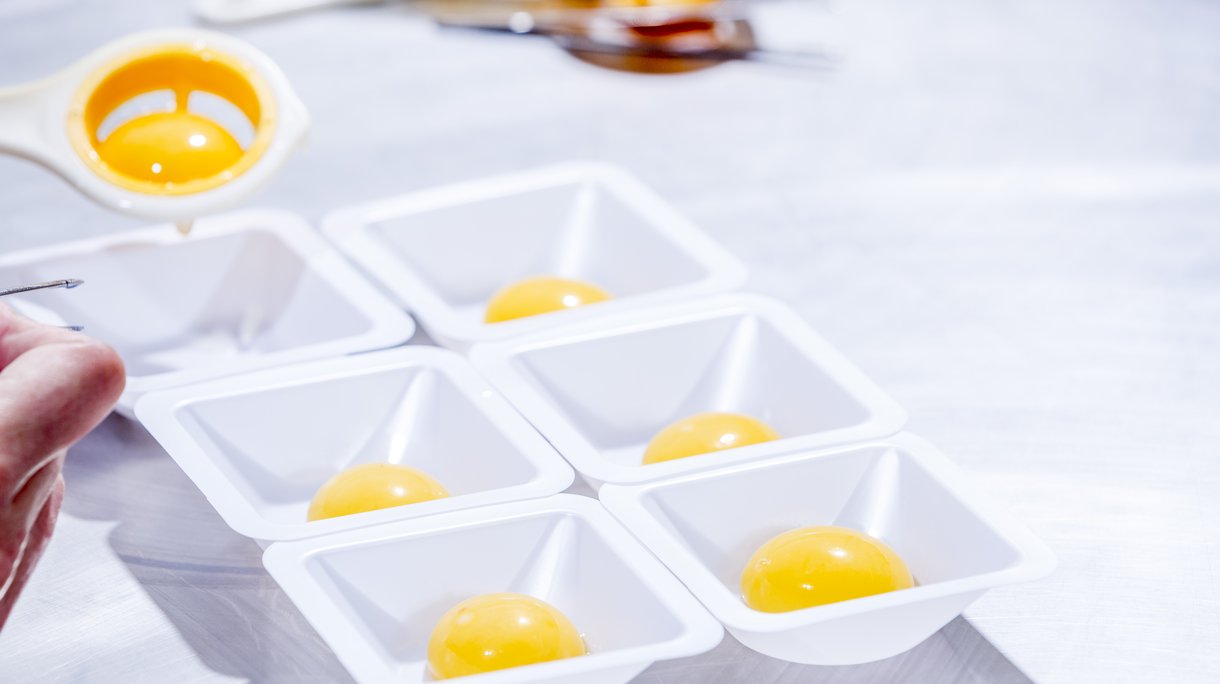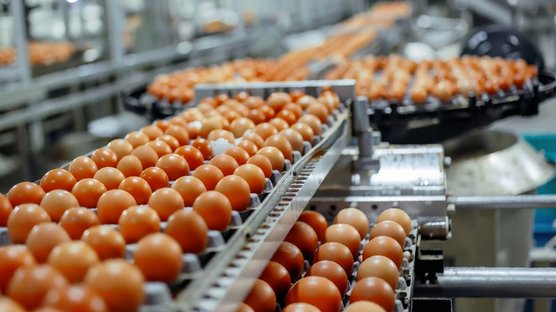
Published on Oct. 10, 2019
What is Egg Quality
As a result of the large diversity in the potential uses of eggs and the subsequent demands of the consumer, it is quite a challenge to define egg quality according to everyone’s standard.
A. Kramer (1951) has defined quality as “the sum of characteristics of a given food item which influence the acceptability or preference for that food by the consumer”. Based on this definition, it is clear that egg quality will mean different things to different people as the consumer’s perception of quality varies depending on their intended use of the egg and their own preferences. There are a number of factors we, as a breeding company, focus on when it comes to egg quality. What are these factors and how do environmental factors impact quality?
Eggshell quality

The vast majority of eggs sold in the world are sold in their shell (table eggs), therefore the consumers’ first impression is based on their perception of shell quality. Shell quality can be split up in several categories.
Eggshell integrity
Defects considered under this category includes cracks and thin shelled, or shell-less eggs. Eggs with cracks are sorted out during the egg grading process as cracked eggs are more prone to microbial contamination. The biggest cause for cracks is via mechanical damage, that could by caused by the birds themselves, or as a result of poor management practices like infrequent egg collection, poor design of the housing system and egg belt or running the feed chain during the peak hours of egg production (disturbing the birds on the nests).
Eggshell strength plays an important role as weaker shelled eggs are more prone to breakages and cracks. Shell strength is affected by a wide range of factors:
- Egg size: in general, smaller eggs have stronger shells. Unfortunately, hens have a finite capacity to deposit calcium during eggshell formation and as a result, the same amount of calcium needs to be divided over a larger area.
- The hens’ age: young hens have a higher chance to produce shell less eggs as their shell glands have not yet matured, besides, young hens have a higher tendency to produce double-yolk eggs during the first weeks of production. As eggs grow bigger when hens are getting older, shell strength goes down (see above
- Stress event: a single stress to your flock can be enough to disturb the process of egg formation for several days. Stress can easily result in soft or thin-shelled eggs, or in misshapen eggs. In worse cases, the egg can break while still in the oviduct.
- Heat stress: high temperatures inside the poultry house often reduce feed intake, and thereby reducing calcium intake which results in an insufficient amount of calcium available for proper eggshell formation.
- Nutrition: adequate dietary minerals and vitamins are essential for good eggshell quality, the role of drinking water in the supply of minerals and trace elements should not be overlooked. The hens’ diet should be well balanced with the proper amounts of calcium and phosphorus available as calcium and phosphorous are essential in forming the eggshell.
- Vitamin D: Vitamin D plays an important role in the proper utilization of calcium and phosphorous, a lack of Vitamin D in the diet results in weaker eggshells and weaker bones.
- Diseases: the most well-known disease affecting eggshell quality is Infectious Bronchitis (IB), which is caused by a coronavirus which attacks the mucus membranes of both the respirator and the reproductive tracts. Also the adenovirus that causes the Egg drop Syndrome (EDS) results in thin-, soft-shelled or shell-less eggs.
- Genetics: the heritabilities of shell strength are moderate (h² in the range of 0.25 – 0.35). Eggshell breaking strength is an important trait in our breeding programs and intensive genetic selection for more than half a century has resulted in hens that are able to produce eggs with higher breaking strength and maintain these high levels for longer production periods.
Eggshell Texture
Rough shells, pimples, pinholes and mottled shells are all eggshell defects associated with the texture of the eggshell. The main factors are:
- Disease: Infectious Bronchitis (IB), infectious laryngotracheitis (ILT) and avian encephalomyelitis (AE) can be linked to the occurrence of textural defects.
- Genetics: in our breeding program we record all these deviations, although heritabilities are low to moderate (h² in the range of 0.05 – 0.25) we make steady progress with every new generation.
- Management: inadequate water supply, sudden changes in lighting programs, poor ventilation and too high stocking densities can all result in an higher incidence of shell defects.
Shape
The shape of an egg is extremely important as the proper egg shape gives a better fit in the egg boxes and egg trays. Misshapen eggs have a shape which differs from the smooth normal shape, think of flat sided eggs, body checked eggs, and the Ping-Pong ball shaped eggs. Main factors related to misshapen eggs are:
- Disease: Infectious Bronchitis (IB), Egg Drop Syndrome (EDS), Avian Influenza (AI) and New Castle Disease (NCD) are all linked to result in a high incidence of misshapen eggs as they negatively affect the albumen quality, whilst the albumen and its surrounding membranes provides the structure on which the eggshell is deposited.
- Stress: overcrowding, stress, poor lighting patterns and improper handling can result in body checked eggs and flat sided eggs.
- Age: young birds, with shell glands that are still immature, may produce misshapen eggs.
Color
Eggshell color is primarily determined by the breed. Leghorns produce white eggs, Rhode Island Reds brown eggs and a cross between the aforementioned tinted eggs. Besides, there are all the specialty breeds which produce chocolate brown, green or blue eggs. Any factor which causes a disruption will affect the color and the color uniformity of the eggshell. These factors are:
- Stress: Epinephrine, a stress hormone, will cause a delay in oviposition and cessation of shell gland cuticle formation, which can cause pale shelled eggs to be produced. Stressors may include, amongst others, high cage density, loud noise and handling
- Age of bird: As birds age increases, the intensity of pigment decreases. This may be due
- to decreasing production of pigment or increased surface area over which available pigment is distributed.
- Disease: New Castle Disease (NCD) and Infectious Bronchitis (IB) are both examples of viruses which affect the mucus membranes of the respiratory and tract. They cause the shell to become abnormally thin and pale.
- Genetics: eggshell color is heritable, heritabilities are moderate to high (h² in the range of 0.35 – 0.6). Breeding directions are clear: white eggs are selected to become whiter, brown eggs to become darker and to decrease the natural drop in eggshell color as much as possible as the hen is aging.
Cleanliness is probably the easiest aspect of eggshell quality to control; proper management plays an important role in keeping your eggs clean. Most eggs are clean when laid and subsequently become contaminated with fecal material or other contaminants.
- Management: Good management practices can help to reduce the number of dirty eggs. These practices include frequent collection of eggs, as well as regular maintenance and cleaning of cage and nest floors, egg belts and roll out trays.
- Nutrition and gut health: factor which causes diarrhea in the birds will also result in an increase in the number of dirty eggs collected.
- Blood smears on eggs can be minimized by good pullet management, including weight for age and proper lighting programs. Do not force and stress your hens to come into lay!
Internal egg quality

Unlike external (shell) quality, internal quality of the egg begins to decline as soon as the egg is laid. Egg handling and storage practices have a significant impact on the quality of the egg, it is the internal quality of the egg that is most important to the consumer. The aspects of internal quality are significantly more difficult to observe or evaluate in the intact egg. Internal egg quality can be split up in the following:
Yolk quality
Yolk quality is determined by its color, texture, firmness and smell of the yolk. The primary determinant of yolk color is the xanthophyll (pigment) content of the diet consumed. It is easy to manipulate the yolk color of eggs by the addition of xanthophylls to the diet.
Pale yolks can result from any factor which alters or prevents the absorption of pigments from the diet or the deposition of these pigments in the yolk. These factors could be:
- Worms
- Decreased liver function
- Coccidiosis
The yolk of a freshly laid egg is round and firm, however, as the egg ages and the vitelline membrane degenerates, water from the albumen moves into the yolk and gives the yolk a flattened shape.
Albumen quality
The quality of the albumn is related to the consistency, the appearance and its functional properties.
- Haugh Units (HU): a measurement for the consistency of egg albumen. Haugh Units are calculated from the height of the albumen and the weight of the egg. Haugh units decrease with increasing bird age.
- Genetics: the breed plays an important role in albumen consistency. All breeds show a decrease in Haugh Units over their lifetime, but there are breeds that start off with very high Haugh Units. Heritabilities for Haugh Units are moderate (h² in the range of 0.25 – 0.35).
- Egg storage: As the egg ages and carbon dioxide (CO2) is lost through the shell, the contents of the egg become more alkaline, causing the albumen to become transparent and increasingly watery. At higher temperatures, loss of CO2 is faster and the albumen quality deteriorates faster. Frequent egg collection, and storage of eggs under cool temperatures will maintain longer Haugh Units.
- Albumen color: excesses of vitamin B (riboflavin) can cause the albumen to become green. Long storage under poor conditions results in yellowish albumen.
Blood spots
Blood spots may vary from indistinguishable spots on the surface of the yolk to heavy contamination throughout the yolk. Blood spots are normally associated with the yolk, but occasionally, blood may be diffused through the albumen as well. Blood spots occur when small blood vessels in the ovary rupture when the yolk is released. Major causes are:
- Vitamin K deficiency, as this plays an important role in blood clotting, and resulting in an increased occurrence of blood spots.
- Genetics: differences occur between genetic strains. In our breeding program we select against blood spots, but heritabilities are low (h² 0.05-0.10).
Meat spots
These are usually associated with the albumen rather than the yolk and often consist of small pieces of body tissue. Some may consist of partially broken-down blood spots or pigments. The occurrence of blood spots varies with strain of bird, increases with the age of the birds and is higher in brown egg layers. In our breeding we select against meat spots, but as with blood spots, heritabilities are low (h² 0.05-0.10).
Continuous investment in our breeding program has resulted in genetic progress for both egg production and quality. Our people are passionate about raising the bar in genetic selection by using the latest tools in data collection and examining egg market needs.
References
Butcher, G. D. and Miles, R. D., 2003a. Concepts of Eggshell Quality. University of Florida.
http://edis.ifas.ufl.edu/pdffiles/VM/VM01300.pdf
Curtis, P. A., Gardner, F. A. and Mellor, D. B., 1985. A Comparison of Selected Quality and Compositional Characteristics of Brown and White Shell Eggs. 2. Interior Quality. Poultry Science, 64, 302 – 306.
Gerber, N., Factors affecting egg quality in the commercial laying hen: a review https://eggfarmers.org.nz/wp-content/uploads/2012/04/factors_affecting_egg_quality.pdf
Kramer, A., 1951. What is quality and how can it be measured: From a food technology point of view. In: Market Demand and Product Quality. Mktg. Res. Workshop Rept., Michigan State College.
Koelkebeck K.W., 1999. What Is Egg Quality and Conserving It? University of Illinois.
http://www.traill.uiuc.edu/poultrynet/paperDisplay.cfm?ContentID=522
MAFF, undated. Egg Quality Guide. http://www.defra.gov.uk/foodrin/poultry/pdfs/eggqual.pdf
Solomon, S. E., 1991. Egg and Eggshell Quality. Wolfe Publishing Ltd., London, England.
Williams, K. C., 1992. Some factors affecting albumen quality with particular reference to
Haugh unit score. World’s Poultry Science Journal, 48: 5 – 16.



